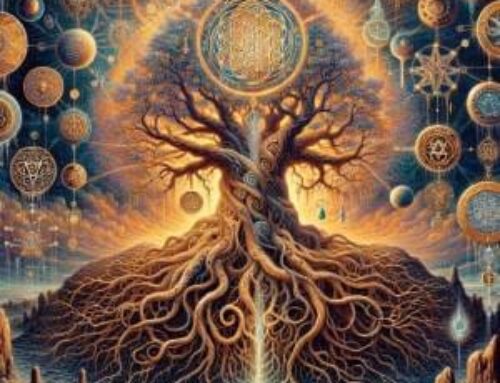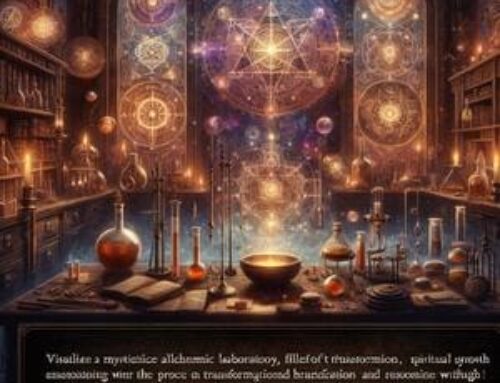Contents
Introduction
Ah, “the Philosophers Stone “– a cornerstone of alchemical tradition. It’s not merely an elusive substance but a symbol of profound transformation. Legends speak of its power to transmute base metals into gold and bestow immortality. Yet, its true essence lies in its representation of spiritual enlightenment and mastery over the material and spiritual realms. The quest for the Philosophers Stone encapsulates the alchemist’s ultimate pursuit, embodying the transformative power of nature and the journey towards self-realization. In this article, we delve into the symbolism, alchemical process, and spiritual significance of the Philosophers Stone, drawing insights from Elias Rubenstein’s “Alchemy: Secrets of Consciousness Transformation.” (1)

Symbolism and Purpose
The Ultimate Alchemical Achievement
The Philosophers Stone, or Lapis Philosophorum, stands as the pinnacle of alchemical endeavor. It signifies the transcendence of both matter and spirit, the unlocking of nature’s secrets, and the attainment of perfection. Alchemists revered it as the key to immortality, the bridge between the mortal and the divine. This stone is a powerful symbol, encapsulating the ideals of enlightenment, purity, and the unity of all things.
The Union of Opposites
In the alchemical tradition, the Philosophers Stone embodies the union of opposites – spirit and matter, heaven and earth. This concept is central to alchemy, teaching that true transformation arises from harmonizing dualities. The stone represents balance and integration, essential for achieving spiritual and material perfection. It symbolizes the divine potential within all beings and the harmonious relationship between the physical and spiritual realms.
Embarking on the Alchemical Process
Kabbalah emphasizes the need for balance between opposing forces within the Sephiroth and in the moral and physical universe (2).
Calcination and Dissolution
The alchemical journey towards the Philosophers Stone begins with calcination. Here, base material is subjected to intense heat, reducing it to ash. This stage represents the burning away of impurities and the destruction of the old self. Following calcination is dissolution, where the ash dissolves in a solvent, symbolizing the dissolution of the ego and the merging of the alchemist’s consciousness with the universal mind. These initial stages are crucial for purifying the base material, preparing it for further transformation.
Coagulation and Fermentation
Coagulation involves recombining purified elements into a new, stable substance, symbolizing the integration of the alchemist’s refined spirit with their physical form. Fermentation follows, introducing new life and energy into the alchemical mixture. This stage represents the awakening of divine wisdom and the infusion of spiritual vitality, leading to the rebirth of the alchemist as a transformed being. Fermentation signifies a deeper connection to the divine and the rejuvenation of both body and soul.
Distillation and Sublimation
Distillation involves heating the substance to separate its pure essence from impurities, reflecting the ongoing quest for self-improvement and purity. The final stage, sublimation, transforms the purified substance into a higher form, representing the attainment of spiritual enlightenment and the manifestation of the Philosopher’s Stone. Through sublimation, the alchemist transcends the physical realm and achieves divine consciousness, completing the Great Work.
Spiritual Significance
Inner Transformation and Enlightenment
Spiritual journeying is a lifelong process that involves exploring one’s inner self and a larger cosmic consciousness, often leading to transformational experiences and assisting others in healing processes (3).
The Philosophers Stone transcends its physical form; it is a metaphor for inner transformation and enlightenment. The process of creating the stone mirrors the alchemist’s journey of self-discovery, involving deep introspection and the purification of the soul. This spiritual journey aims to strip away the ego and material attachments, revealing the true divine essence within. By achieving the Philosopher’s Stone, the alchemist attains a state of enlightenment, understanding the interconnectedness of all things.
The Key to Spiritual and Material Perfection
The Philosophers Stone is considered the key to both spiritual and material perfection. It symbolizes the ultimate goal of alchemical work, where the alchemist transforms not only metals but also their own nature. This transformation leads to the realization of one’s divine potential and the fulfillment of their highest spiritual aspirations. The stone represents the culmination of the alchemist’s efforts to achieve balance, harmony, and unity with the divine.
Conclusion
The Philosophers Stone stands as the quintessential symbol of alchemy, embodying a profound journey of transformation, enlightenment, and unity. The alchemical process of creating the stone serves as a metaphor for the spiritual path of self-discovery and perfection. For those who wish to explore these ancient mysteries further, the Hermetic Academy offers invaluable resources and guidance on the path to achieving the Philosopher’s Stone and beyond.
FAQ- Philosopher’s Stone Alchemy
1. What is the Philosopher’s Stone in alchemy?
A: The Philosopher’s Stone is a legendary alchemical substance that can transform base metals into gold and grant immortality. It symbolizes the ultimate goal of alchemy, representing spiritual and material perfection.
2. What are the main stages of creating the Philosopher’s Stone?
A: The main stages include calcination, dissolution, coagulation, fermentation, distillation, and sublimation. Each stage represents a step in the spiritual and material transformation necessary to create the Philosopher’s Stone.
3. What does the Philosopher’s Stone symbolize?
A: The Philosopher’s Stone symbolizes the attainment of spiritual perfection and enlightenment. It represents the highest state of being that an alchemist can achieve, signifying the successful completion of the alchemical process.
4. How does the Philosopher’s Stone relate to spiritual practices?
A: The Philosopher’s Stone relates to spiritual practices by emphasizing inner transformation, the harmonization of dualities, and the realization of one’s divine potential. It teaches the practitioner to align with the universal laws of nature and achieve a state of enlightenment.
5. Where can I learn more about alchemical practices?
A: For those interested in delving deeper into the mysteries of alchemy, the Hermetic Academy offers extensive resources and guidance on the path to spiritual transformation and enlightenment.
References
(1) Rubenstein, E. (2023). Alchemy: Secrets of Consciousness Transformation. Hermetic World, Paphos.
(2) Mathers, S. L. M. (1887). The Kabbalah Unveiled. London: George Redway.
(3) Keegan, L. (1991). Spiritual Journeying. Journal of Holistic Nursing, 9, 14 – 3. https://doi.org/10.1177/089801019100900103.





